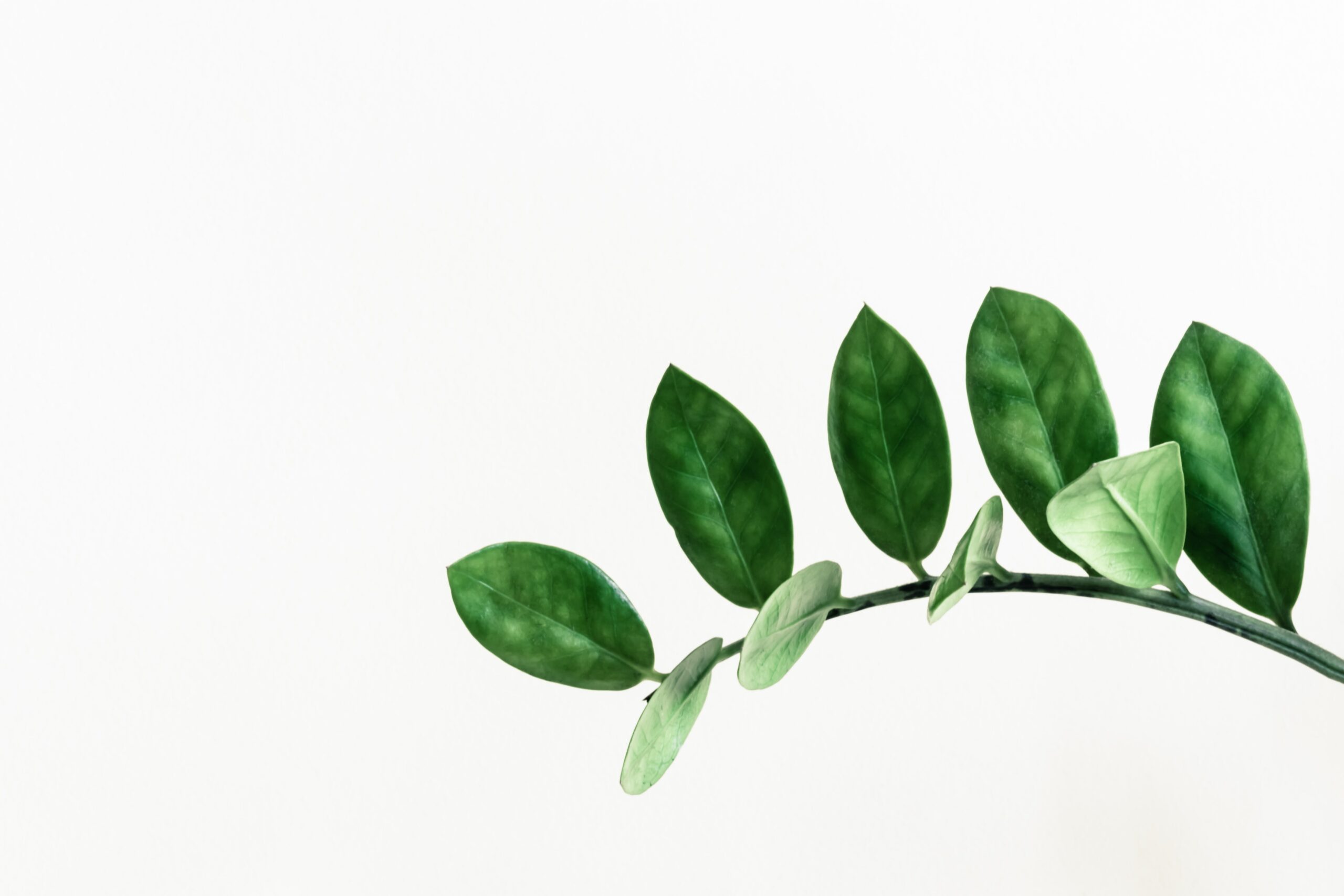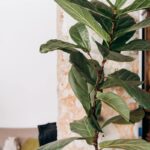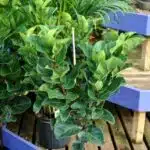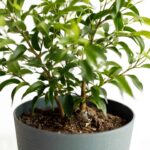As a staple of the modern home, the fiddle-leaf fig tree is making quite a comeback. Its iconic large leaves have been gracing the pages of interior design magazines and social media feeds alike, and with good reason. These unique plants are easy to care for and offer a statement piece to any outdoor or indoor space. With just a little bit of know-how, you can become an expert in growing and caring for your own fiddle-leaf fig!
Do you want to add an eye-catching centerpiece to your home? The fiddle-leaf fig may be your answer. This tropical plant is known for its large, glossy green leaves that resemble the shape of a violin—hence its name. Not only is it visually appealing, but it’s also easy to care for when given the right environment and attention.
From knowing what type of potting soil works best to understanding when it needs water, there are many tips and tricks you should consider if you’re looking to bring this trendy plant into your life. So if you’re hankering after some greenery with a hint of style, read on for everything you need to know on how to grow and care for your very own fiddle-leaf fig!
Choose A Suitable Spot For Your Fiddle-Leaf Fig
Choosing the right spot for your fiddle-leaf fig is key to its success. The ideal spot would have bright, indirect light. You’ll want to place it near a window that doesn’t get direct sunlight, as this can damage the leaves. If you don’t have a spot like this in your home, you can try using an artificial light source such as a fluorescent or LED lamp that’s placed at least a foot away from the plant.
When it comes to temperature, fiddle-leaf figs prefer warm environments with temperatures between 65 and 80 degrees Fahrenheit. Make sure you’re also keeping your plant away from air vents and other sources of cold air. It’s important to keep humidity levels high for this kind of plant by misting it regularly and wiping down the leaves with a damp cloth.
Finally, make sure your fiddle-leaf fig is in well-draining soil that has been amended with compost or fertilizer, as this will help provide the nutrients needed for growth. Additionally, provide adequate water when the top two inches of soil are dry; if there’s too much moisture in the soil then the roots can become waterlogged which can lead to root rot and other issues. With proper care and attention, your fiddle-leaf fig should thrive in its new home!
Provide The Right Amount Of Light
Finding the right light environment is key to a healthy fiddle-leaf fig. The location of the plant should be in an area where it will receive bright, indirect sunlight. A south- or east-facing window is an ideal spot, as long as it isn’t in direct contact with hot sunshine. If your room lacks good natural light, you’ll need to use artificial lighting and supplement with either a fluorescent tube or LED grow light.
You should also be aware that too much light can cause leaf scorch and sunburn. To prevent this, keep the plant away from direct sunlight and move it if it starts to get too much exposure. It’s also important to rotate the pot occasionally so all parts of the plant receive even light.
The amount of light your fiddle-leaf fig needs will change during different times of year, so keep an eye on how much sun your plant gets when adjusting its position. With careful observation and maintenance, you can make sure your fiddle-leaf fig receives just the right amount of light for optimal health and growth.
Know The Right Temperature For Fiddle-Leaf Fig
The fiddle-leaf fig is a beautiful addition to any home, with its large, glossy leaves providing a striking aesthetic. At the same time, providing the right temperature for this tropical plant is essential for it to thrive. To ensure your fiddle-leaf fig stays happy and healthy, here’s what you need to know about temperature requirements.
When it comes to temperature for the fiddle-leaf fig, it’s important to keep in mind that this plant prefers temperatures between 65 and 75 degrees Fahrenheit. During winter months, if your home gets colder than this range, you should consider relocating your plant to a warmer spot such as near a window or door. In warmer months, if temperatures go above 75 degrees, try moving it to a cooler location in the house.
In addition to temperature fluctuations, be mindful of drafts or air conditioners that could be too cold or too hot for your plant. If these areas are unavoidable in your home, try creating an artificial environment around the plant by using sheer curtains and/or humidifiers and fans. By making sure the temperature is just right for your fiddle-leaf fig, you can ensure its continued health and growth for many years ahead.
Understand The Need For Humidity
A stitch in time saves nine.” It is true that proper care and maintenance of plants can save much effort down the line. This especially applies to fiddle-leaf figs, which require specific conditions for optimal health. Understanding the need for humidity is an important part of successfully growing this tropical plant indoors.
Humidity plays a role in keeping the leaves of fiddle-leaf fig healthy and vibrant. If it’s too low, the leaves will start to brown or curl. To increase humidity levels, misting with a water bottle can be done daily or placing a humidifier nearby may help. It’s also beneficial to group plants together as they can create their own microclimate, helping to maintain higher levels of humidity in the air around them.
The most important way to keep humidity at its optimum level is regular watering. Too much or too little water can both cause problems with humidity levels; make sure you understand how often your particular plant needs watering – this varies depending on the size and type of pot used, as well as other environmental factors like sun exposure and temperature. With proper maintenance and some understanding of these basics, your fiddle-leaf fig will be thriving in no time!
Provide Adequate Water
The theory of ‘too much water kills plants’ is a common one, but does it hold true for the fiddle-leaf fig? On the contrary, this tropical species loves moisture and needs to be watered regularly. As we explore how to provide adequate water for this beloved houseplant, let’s first understand why it’s so important.
Watering a fiddle-leaf fig correctly is essential because it helps promote healthy leaf growth. When the soil is kept consistently moist, new leaves will appear more frequently and larger than they would if the plant were underwatered. Furthermore, the roots are less vulnerable to rot when they receive an appropriate amount of moisture from their environment.
A good rule of thumb for watering fiddle-leaf figs is to check the top two inches of soil every week or two. If it feels dry all the way through, then it’s time to water and avoid letting the soil dry out completely in between sessions. It’s also important to ensure that excess water can drain away quickly from its pot after each watering session so that your plant isn’t left sitting in standing water. With these tips in mind, you’ll be on your way to growing a healthy and happy fiddle-leaf fig at home!
Potting And Repotting The Fiddle-Leaf Fig
When repotting a fiddle-leaf fig, it’s important to use the right pot size and soil. The pot should be large enough for the roots to fit comfortably without being cramped and should have drainage holes in the bottom. Well-draining soil is also key–it helps to ensure that excess water doesn’t lead to root rot. Consider a soil mix specifically designed for fiddle-leaf figs that contains perlite and other materials that help with drainage.
When it’s time to transplant your fiddle-leaf fig, take care not to disturb its roots too much. Gently remove the plant from its old container, shake off any excess soil, and inspect the roots. At this point, you can prune away any damaged or dead roots before placing it in a new pot with fresh soil. Be sure to fill in the edges of the pot with extra soil so that the plant sits at about the same height as before.
Once potted up, your fiddle-leaf fig will need some extra attention until it settles back into its new home. Give it plenty of bright indirect light and keep an eye on how much water you’re giving it–too much can easily cause root rot if drainage isn’t adequate. When watering your fiddle-leaf fig, wait until the top two inches of soil feel dry before adding more water. This will help prevent overwatering and give your plant a chance to settle into its new environment quickly and easily.
Fertilize The Plant Appropriately
Alluding to a renowned saying, “you are what you eat”, the same holds true for plants. Appropriate fertilization can help bring out the best in any plant – including the Fiddle-Leaf Fig. Though they tend to be low-maintenance, there are some key points when it comes to fertilizing these majestic plants.
Fertilizer should be administered according to the instructions on the packaging, and applied no more than once a month during the growing season. It’s important not to overdo it – too much fertilizer can cause brown leaf tips or even root burn that could damage your plant. The nutrients in fertilizer can also help reduce problems such as yellowing leaves and slow growth rates. However, if your Fiddle-Leaf Fig is kept in an area with bright light, then frequent fertilization may not be necessary; soil that is too richly fertilized will result in fewer leaves and less of an attractive shape for your fig tree.
When deciding which type of fertilizer to use on your Fiddle-Leaf Fig, look for one specially formulated for houseplants or trees with a balanced nitrogen-phosphorus-potassium ratio. This trio of macronutrients will give your fig tree everything it needs to stay healthy and strong. Remember that organic products are always preferable over synthetic ones as they provide more beneficial microorganisms that help keep the soil healthy and nourished. With proper care and fertilizer, you’ll have a happy and healthy Fiddle-Leaf Fig Tree!
Prune The Plant As Needed
Pruning is an important step in keeping your fiddle-leaf fig healthy. It helps to direct the plant’s energy and maintain its shape, and it also encourages new growth. When pruning, you should use sharp, sterile scissors or shears and make sure to cut off any brown or dead leaves. You can also remove any long stems that are getting in the way of the overall shape of the plant.
It’s important to be careful when pruning your fiddle-leaf fig so as not to damage any healthy parts of the plant. Always make sure you’re removing only what needs to go, leaving all healthy parts intact. You can also use a pair of tweezers if needed to reach difficult spots and remove smaller leaves or stems.
Regular pruning will help keep your fiddle-leaf fig looking neat and encourage new growth for a fuller, healthier plant. With proper care and attention, you’ll soon have a beautiful indoor houseplant that will add life to your home for many years to come. Now, it’s time to move on to pests and diseases that you need to watch out for when caring for your fiddle-leaf fig.
Pests And Diseases To Watch Out For
Have you ever wondered what dangers your beloved fiddle-leaf fig might face? Pests and diseases can cause a lot of harm to plants, so it’s important to know what signs to look for. In this section, we’ll discuss the potential pests and diseases that could affect your fiddle-leaf fig and how to protect it from them.
The most common pests that attack fiddle-leaf figs are aphids, mealybugs, spider mites, scale insects, and thrips. All of these pests can cause damage to leaves or branches if they aren’t dealt with as soon as possible. To get rid of them, you should use insecticidal soap or neem oil on the affected area.
As far as diseases go, the most common ones affecting fiddle-leaf figs are root rot, leaf spot disease, and powdery mildew. If you notice any discoloration or wilting in the leaves or stems of your plant, it’s likely due to one of these issues. To help prevent them from occurring in the first place, make sure you’re watering your plant appropriately and keeping it away from drafts or extreme temperatures. If an issue does arise, try using a fungicide such as copper sulfate to treat it.
All these pests and diseases can be dangerous for a fiddle-leaf fig if not treated correctly. It’s important to keep an eye out for any signs of infestation or infection so that you can quickly take steps to protect your beloved plant!
Common Fiddle-Leaf Fig Problems
Despite its popularity, the fiddle-leaf fig isn’t without problems. According to a survey by the University of Florida, an estimated 78% of houseplant owners have experienced issues with their plants. So it’s no surprise that common fiddle-leaf fig problems can arise.
There are several issues that could plague the fiddle-leaf fig, such as leaf yellowing or drooping leaves due to inadequate watering and low light exposure. Leaf burn caused by too much direct sunlight is another issue, as well as infestations from pests like mealybugs and spider mites. These pests feed off the plant’s sap and can cause brown spots on the leaves and stunted growth in extreme cases.
To prevent these common fiddle-leaf fig problems, be sure to give your plant appropriate amounts of water and light for its needs; if you’re unsure about how much or how little your specific species needs, consult a local expert or look up information online. Additionally, make sure to regularly inspect your plant for any signs of pests or disease. With proper care and attention, you can ensure that your fiddle-leaf fig stays healthy and happy for many years to come! Moving forward, let’s look at how you can propagate this beautiful houseplant.
Propagating The Fiddle-Leaf Fig
Propagating the fiddle-leaf fig is a great way to increase your collection of these beautiful plants. It’s simple and straightforward, taking just a few steps to set up. To start, you’ll need to find a healthy stem cutting from an adult fiddle-leaf fig. Then, you’ll want to make sure that there are at least two leaves on the cutting and that it has been in the water for at least two weeks before attempting any propagation.
Once the cutting has had time to adjust and grow roots, it’s time for planting. The best soil for propagating fiddle-leaf figs is a mix of equal parts potting soil and peat moss. You should also make sure there are plenty of drainage holes in the pot so that excess water can drain away easily. Lastly, it’s important to keep the soil damp but not saturated; too much moisture can lead to root rot or fungal diseases.
After planting your cuttings, be sure to place them in bright, indirect light in order to encourage successful growth. Keep an eye out for signs of distress such as yellowing leaves or wilting stems so that you can take action quickly if needed. With proper care and attention, your new fiddle-leaf fig will soon be ready to enjoy! Moving on, let’s look into some tips for moving and transporting these beautiful plants safely...
Tips For Moving And Transporting Fiddle-Leaf Fig
Moving a fiddle-leaf fig is like moving a delicate piece of art — it requires careful handling and attention. When transporting such an exquisite houseplant, it’s important to take all necessary precautions to keep the leaves intact and ensure a safe journey for your beloved ‘tree’.
First, water your plant the day before you plan on moving it. This helps to prevent the roots from drying out during transit. Next, carefully remove your fiddle-leaf fig from its pot, making sure that you support the stem with both hands. Wrap the roots in damp paper towels and then place them in a secure box that is lined with newspaper or packing paper. Make sure that you cushion the sides of the box with bubble wrap if necessary and include some ventilation holes so oxygen can reach the plant’s roots.
Finally, try to move your fiddle-leaf fig as quickly as possible by car or taxi to avoid any shock from temperature fluctuations or air pressure changes during air travel. Upon arrival at its new destination, inspect for signs of damage and carefully unwrap the root ball before repotting into a fresh container filled with well-draining soil mix suitable for houseplants. With these simple steps, you can transport your beloved fiddle-leaf fig safely and stress-free!
Ways To Display Fiddle-Leaf Fig
When it comes to stylish home decor, the fiddle-leaf fig is a popular choice. Take my own home, for instance – I have two of these plants in my living room, and they really add a touch of green and vibrancy that can’t be matched by any other plant! The next step after getting your fiddle-leaf fig is to find the perfect place to display it. Here are some tips for doing just that.
One great way to show off your fiddle-leaf fig is to put it in a pot with other plants. If you’re creative enough, you can find a variety of different plants that will look great together, such as succulents or even a few small palms! This will create an eye-catching display that’s sure to be admired by guests. Another option is to hang the fiddle-leaf fig from the ceiling or mount it on a wall so that its lush foliage hangs down like curtains. This will give your living space an extra bit of drama and make it truly stand out from the other decorations in your home.
Finally, if you want something more subtle but still eye-catching, why not try placing the fiddle-leaf fig in an ornamental planter? There are plenty of unique designs available and you can choose one that matches your style perfectly – whether you prefer modern and sleek or rustic and classic. With this approach, you’ll be able to enjoy all the beauty of your fiddle-leaf fig without overwhelming the rest of your decor.
No matter how you decide to display your fiddle-leaf fig, giving careful consideration to its placement will ensure that it adds the perfect finishing touch to any room in your home. Now it’s time to explore what kind of companion plants work best alongside this popular houseplant.
Best Companion Plants For Fiddle-Leaf Fig
Believe it or not, the fiddle-leaf fig (Ficus lyrata) is one of the most popular houseplants in the world. In fact, National Gardening Survey data show that more than five million households across America own one. So if you’ve got a Fiddle-Leaf Fig of your own, you’re part of a big club!
Now that your Fiddle-Leaf Fig is growing strong, it’s time to think about what companion plants could bring out its best qualities even further. Don’t worry if you don’t have a green thumb; there are plenty of easy and beautiful options for any kind of growing situation. Here are some great choices:
Peace lilies (Spathiphyllum spp.), pothos (Epipremnum aureum), wandering jew (Tradescantia zebrina), arrowhead vines (Syngonium podophyllum), prayer plants (Maranta leuconeura), and philodendrons (Philodendron spp.) all make excellent companions for fiddle-leaf figs. These plants are tolerant of low light and irregular watering schedules and can help add a layer of texture and greenery around your Fiddle-Leaf Fig.
Each companion plant will bring something unique to the scene, whether it be lush foliage, climbing tendrils, or eye-catching variegation. With just a little bit of research into each plant’s needs, you can create an indoor oasis filled with lush greens and rich textures – perfect for showing off your beloved Fiddle-Leaf Fig!
Decorating With Fiddle-Leaf Fig
When it comes to decorating with a fiddle-leaf fig, the options are endless. This type of plant is incredibly versatile and can be used in many different ways. Whether it’s placed alone as a focal point or mixed with other plants, a fiddle-leaf fig can easily enhance any space.
To make sure your plant stands out, choose an area that has plenty of natural light or provide the best artificial lighting you can. You can also add some interest to the area by using decorative containers or planters to highlight the beauty of the leaves. Additionally, if you have a small space, consider mounting the plant on a wall and add some wall hangings around it for extra flair.
No matter how you decide to decorate with your fiddle-leaf fig, just remember to keep its environment ideal for growth; this includes watering and fertilizing regularly and keeping its leaves free from dust. With proper care and attention, your fiddle-leaf fig will not only look beautiful in your home but will also stay healthy for years!
Frequently Asked Questions
How Often Should I Water My Fiddle-Leaf Fig?
The fiddle-leaf fig is a majestic presence that exudes an air of regal elegance, bringing a touch of the outdoors in. Caring for this majestic plant can be daunting but need not be overwhelming. Deciding how often to water your fiddle-leaf fig is an important part of keeping it healthy and thriving indoors.
When deciding how much and how often to water your fiddle-leaf fig, it’s important to remember that they like a good balance between dryness and wetness. It’s best to allow the soil to become lightly dry before watering again, as too much moisture can damage the roots of your plant. The amount of water required for your fiddle-leaf fig will depend on several factors such as light levels, type of soil, and size of pot. A good way to check if your fiddle-leaf fig needs water is by inserting your finger into the soil up to 1 inch (2.5 cm). If the top inch feels dry, then you should give it some water – about one cup per square foot (30 cm) of pot size should do the trick. Water deeply until you see some drainage at the bottom of the pot and then wait until it’s slightly dry before watering again.
Fiddle-leaf figs are a bit finicky when it comes to watering so make sure you don’t go overboard! If you’re unsure about whether or not to water it, err on the side of caution and wait until the top inch feels dry before giving your plant a drink. With consistent care and attention, your fiddle-leaf fig will thrive indoors and bring its distinctive beauty into your home for years to come.
How Often Should I Fertilize My Fiddle-Leaf Fig?
Caring for a fiddle-leaf fig is a rewarding experience, and the key to successful growth is proper fertilization. Fertilizing your plant regularly will ensure that it receives the nutrients it needs for vigorous growth and healthy leaves. But how often should you fertilize your fiddle-leaf fig?
The frequency of fertilizing depends on the age of your plant. If your plant is young, it’s best to fertilize once every two weeks in the spring, summer, and fall months. For older plants, a monthly application of fertilizer during these seasons should suffice. During the winter months, you can reduce fertilizing to once every two months.
It’s important to use a balanced fertilizer specially formulated for houseplants when feeding your fiddle-leaf fig. Additionally, make sure to dilute the fertilizer according to directions before applying it to the soil—overfertilizing can damage your plant’s roots and cause wilting or yellowing of leaves. With proper care and regular feeding, you’ll be able to enjoy this beautiful foliage plant for many years to come!
How Do I Know If My Fiddle-Leaf Fig Is Getting Too Much Light?
When caring for a fiddle-leaf fig, one of the most important things to consider is how much light the plant is getting. Too much light can cause sunburn, while too little can prevent the plant from growing properly. So how do you know if your fiddle-leaf fig is getting too much light?
Signs that your fiddle-leaf fig may be receiving too much light include yellowing or bleaching of its leaves, brown spots on its leaves and stems, and leaf drop. Leaves that are droopy or wilted could also be an indication that the plant is getting too much sun. If you notice any of these signs, it’s best to move your fiddle-leaf fig away from direct sunlight and make sure it isn’t placed near a window with direct sunlight coming in.
It’s important to provide your fiddle-leaf fig with adequate amounts of both natural and artificial light. As long as you keep an eye out for any signs of too much light, your plant should stay healthy and happy. If you’re ever unsure about how much light your fiddle-leaf fig needs, it’s always best to do some research or consult an expert before making any changes to its environment.
What Is The Best Way To Move My Fiddle-Leaf Fig?
Moving a fiddle-leaf fig can be a tricky task – like threading a needle with the slightest of movements. It’s easy to get too rough or not take into account all the tiny details, so caution and precision are key. Much like a jigsaw puzzle, it’s important to properly assess the situation before making any sudden moves.
To start, figure out what type of soil your tree is in and decide where you’d like to move it. If you’re transferring your fiddle-leaf fig to a new pot with different soil, make sure that the soil is well draining and slightly acidic. Otherwise, you could risk overwatering or underwatering your plant. Once you’ve got that sorted out, it’s time to get moving! Gently remove the tree from its pot by holding onto the base of the trunk and carefully pulling outwards until it comes free. Be careful not to damage any of its roots while doing this – these must remain intact for your tree to survive!
When preparing it for its new home, fill up your pot with fresh soil and make sure there are drainage holes at the bottom so that excess water can escape. Place your fiddle-leaf fig in the middle of the pot and fill up around it with more soil until it’s firmly rooted in place. Give it a good drink of water so that all its roots are moistened before covering them up completely – like wrapping an old friend in a warm hug. With some patience and care, you’ll have successfully moved your beloved fiddle-leaf fig without putting too much strain on its delicate branches!
What Types Of Pests And Diseases Should I Watch Out For On My Fiddle-Leaf Fig?
Caring for a fiddle-leaf fig can be like navigating a minefield; one wrong step and you’re in trouble. But with proper care, your beloved fiddle-leaf fig can grow and thrive. One important part of caring for this plant is knowing what types of pests and diseases to watch out for.
Pests are the most common issue with fiddle-leaf figs. These include aphids, mealybugs, scale insects, spider mites, and whiteflies. If you see any of these pests on your plant, use an insecticidal soap or neem oil to eliminate them. You may also need to isolate the affected plants from healthy ones to prevent further spread of the pests.
It’s also important to look out for fungal diseases such as powdery mildew and root rot. Symptoms of these diseases include discolored spots on leaves or stems, stunted growth, wilting leaves, and yellowing foliage. To address these issues, it’s best to consult an expert who can help you figure out how to treat the disease effectively without damaging your plant.
Taking these steps will ensure that your fiddle-leaf fig stays healthy and continues to bring life into your home!
Conclusion
Fiddle-leaf figs are a beautiful and popular houseplant that can add life and beauty to any home. With the proper care and attention, they can thrive indoors for many years. By following the tips outlined in this article, such as watering, fertilizing, and managing light exposure, you can ensure your fiddle-leaf fig will stay healthy and vibrant. Additionally, be sure to pay attention to signs of pests or diseases so that you can take appropriate action when necessary.
Surprisingly, it takes about 2-3 years for a fiddle-leaf fig to reach its full height potential of 6-10 feet! While it may seem like a long time before you get to enjoy the majestic size of this plant, you will be rewarded with an eye-catching statement piece in your home after all the hard work caring for it in those first few years.
With its unique shape and size, the fiddle-leaf fig is a relatively easy houseplant to care for as long as you give it consistent waterings and fertilizer applications. Furthermore, by understanding its ideal light conditions and keeping an eye out for pests or diseases, your fiddle-leaf fig should stay healthy and happy for years to come!





























